![]()
Introduction
Colonne de Juillet and Place de la Bastille in pictures
This page is also available in French
![]()
On 27, 28 and 29 July 1830, Paris rose in revolt and overthrew the monarchy of Charles X, events which were witnessed by Berlioz himself just after the completion of his cantata Sardanapale, written for the Prix de Rome of 1830 (cf. Memoirs chapter 29). Later that year the government decided to build on the Place de la Bastille a commemorative bronze column in honour of the victims of the ‘Trois Glorieuses’ — the three glorious days of the revolution. Work started in 1833 and was completed in 1840. The inauguration of the column was accompanied by the solemn transfer of the bodies of the victims, and Berlioz was commissioned by the Minister of the Interior, Charles de Rémusat, to write the music for the occasion: this was the Symphonie Funèbre et Triomphale.
The story of the commission and first performance of the work is told by Berlioz in his Memoirs (chapter 50; an earlier version of this chapter appeared in Le Monde Illustré in July 1859). The commission was originally made in April 1840, but it was not till 11th July that Berlioz received official confirmation of the order (CG no. 717, cf. 718), though the music was ready before then. Mindful of the disadvantages of open-air performance Berlioz gave a first public hearing of the work on 26 July, two days before the ceremony, at the Salle Vivienne (now no longer extant); the success of this concert performance led Berlioz to repeat it twice in the same venue, on 7 and 14 August. For the official performance, on 28 July, Berlioz led his musicians in procession through the streets of Paris, from near the Louvre to the Place de la Bastille. A letter to his father dated 30 July, two days later, gives a detailed account of this occasion, which should be compared with the version in the Memoirs (CG no. 721):
I reproach myself for not having already told you of the new success I have just scored. But the effort involved in marshalling this musical army was so taxing that I am still exhausted; yesterday I had difficulty in forming letters, so great was the fatigue in the muscles of my hand caused by the movement of my arm and the pressure of the baton.
Everything went perfectly; but the great success was that of the dress rehearsal before the most intelligent section of the Paris public. It is not just the women who wept. After this test, which was decisive for the work itself, there remained that of the performance on stage. Our stage was Paris, its quays and boulevards. The old connoisseurs of military music maintained that I would never be able to perform the funeral march while marching, and that my 210 musicians would not be able to keep together for 20 bars. Experience demonstrated the falsity of such routine predictions. I placed the trumpets and drums at the front to be able to give them the tempo, and I myself walked backwards. As I had foreseen when composing the work, the first bars, which are unaccompanied, could be heard from a distance by the rest of the band. The result was that not only the funeral march, but also the Apotheosis, were played six times during the procession, with extraordinary ensemble and effect. The minister sent me one of his heads of department to compliment me in the warmest way, after the second hearing of the triumphal march which had made a great impression on all the population gathered around and above us. Yesterday evening he got Cavé, the director of the Beaux-Arts section, to write me a letter full of the most emphatic praise [CG no. 720, cf. 722]
This time I wrote the work in such large characters that even the short-sighted were able to read me. As a result, not one person had anything critical to say, which is extraordinary. Mainzer himself, my intimate enemy at the National, allowed himself to praise my composition in his feuilleton yesterday.
However, this does not prove in any way its superiority over my previous symphonies.
But it is an advertisement, a colossal inscription, and everyone has seen it. The enthusiasm displayed by all the musicians towards me verges on awe. (I am saying this to you, father, in the hope that you will not show my letter to anyone except my sisters). I am receiving messages of congratulation in verse and prose. […]
![]()
All the modern photographs reproduced on this page were taken by Michel Austin in 2000; other pictures have been scanned from engravings, postcards and books in our own collection. © Monir Tayeb and Michel Austin. All rights of reproduction reserved.
On the column are inscribed the names of those who fought during the revolution. The gilded statue at the top of the column represents a winged personification of Liberty.
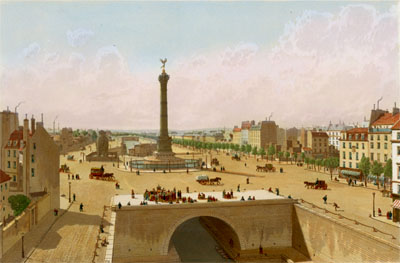
This is an 1880 lithograph by F. Hoffbauer of a picture dated 1841.
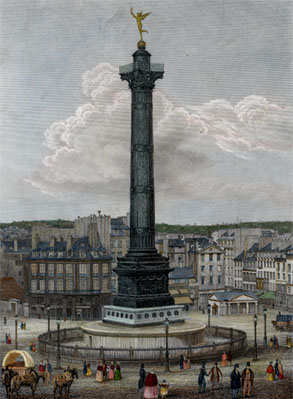
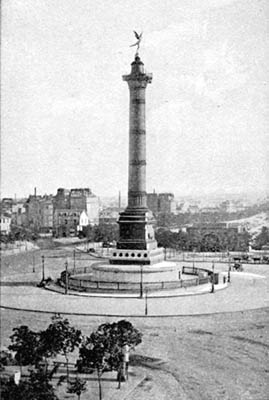
This picture has been scanned from John L. Stoddards Lectures, Volume V – Paris La Belle France and Spain, by John L. Stoddard (Balch Brothers, 1898).
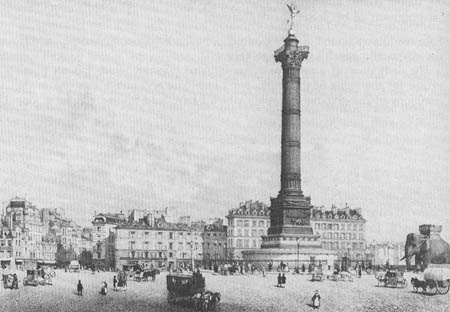
This lithograph has been scanned from Charles Simond, Paris de 1800 à 1900 D’après les estampes et les mémoires du temps (Paris, 1900-1901), volume 2, p. 188, in our collection.
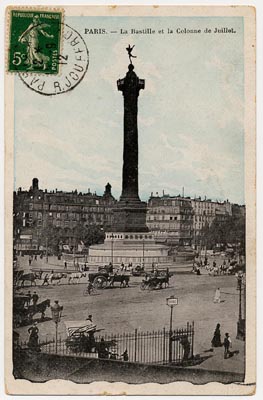
This picture has been scanned from a 1912 postcard.
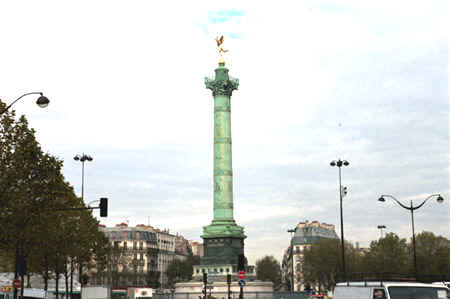
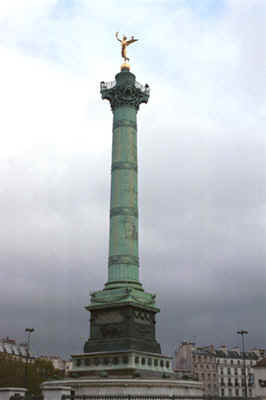

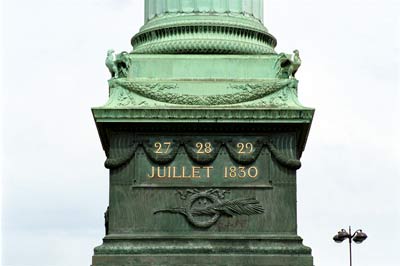
The dates shown, 27, 28 and 29 July 1830, are those of the three days of the revolution, the “Trois Glorieuses”.
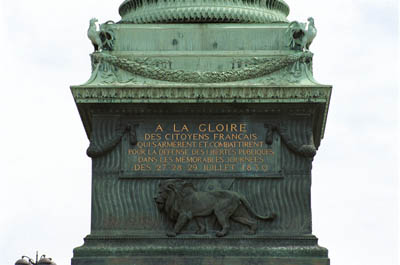
The inscription on the base reads: “For the glory of the French citizens who took up arms and fought in defense of public liberties in the memorable days of 27, 28, and 29 July 1830”.
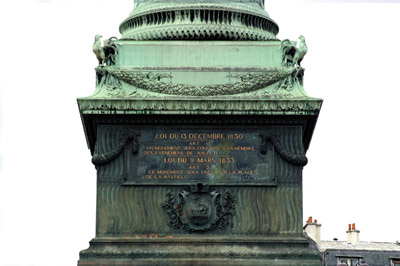
The inscriptions reads: “Law of 13 December 1830, art. 15: A monument will be consecrated in memory of the events of July. Law of 9 March 1833, art. 2: This monument will be erected on the Place de la Bastille”.
![]()
© Monir Tayeb and Michel Austin for all the pictures and information on this page.
Copyright notice: The texts, photos, images and musical scores on all pages of this site are covered by UK Law and International Law. All rights of publication or reproduction of this material in any form, including Web page use, are reserved. Their use without our explicit permission is illegal.